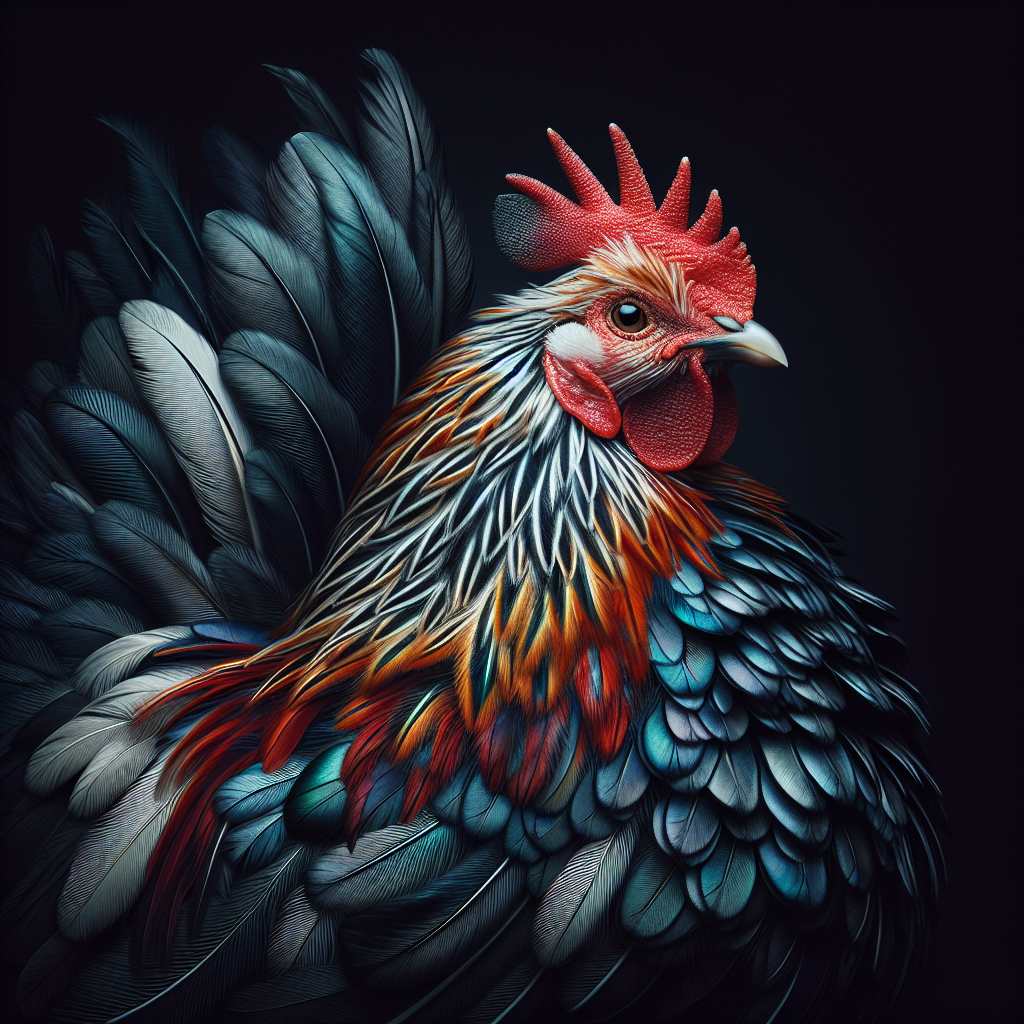Have you ever wondered about the benefits and difficulties of crossbreeding different chicken breeds? Delving into the topic of poultry genetics, this article explores the advantages and challenges of this practice. From enhancing productivity to creating unique and desirable characteristics, crossbreeding offers a world of possibilities for chicken enthusiasts. But along with its advantages come challenges, such as maintaining breed purity and managing potential health concerns. So, whether you’re a seasoned poultry breeder or simply fascinated by the world of chickens, join us as we explore the intriguing world of crossbreeding different chicken breeds.
Improvement in Productivity
Crossbreeding different chicken breeds can lead to an array of advantages, starting with increased egg production. By crossing breeds that are known for their high egg-laying capabilities, you can expect your hens to lay a larger quantity of eggs. This boost in productivity can significantly benefit commercial farmers or backyard enthusiasts who rely on a steady supply of fresh eggs.
In addition to enhanced egg production, crossbreeding can also improve meat quality. By crossing specific breeds known for their meaty attributes, such as large breast size or tender meat texture, you can create a breed that meets consumer demand for high-quality meat. This can also potentially lead to expanding your market reach and attracting customers who prioritize taste and texture when purchasing chicken products.
Another advantage of crossbreeding is improved growth rate. By selecting breeds that have a faster growth rate and combining them, one can cultivate a new breed that reaches maturity at a quicker pace. This advantage can be highly beneficial for commercial farmers who aim to raise chickens with maximum efficiency in terms of time and resources.
Disease Resistance
One of the most significant advantages of crossbreeding different chicken breeds is the enhancement of disease resistance. By utilizing breeds that have demonstrated a strong immunity to common diseases, you can create a breed that is less susceptible to various infections. This increased resistance can minimize the risk of diseases spreading throughout the flock, leading to lower mortality rates and healthier birds overall.
Moreover, reduced susceptibility to common diseases not only benefits the individual chickens but also contributes to the overall biosecurity of the farm. With crossbred chickens that possess superior immunological defenses, the risk of diseases affecting the entire poultry operation is considerably mitigated. This, in turn, can lead to decreased dependence on antibiotics and other medications, promoting a healthier and more sustainable approach to chicken farming.
Genetic Diversity
Crossbreeding different chicken breeds enables the expansion of the gene pool within a flock. This increased genetic diversity can have various advantages, from improved adaptability to enhancing the overall health and vitality of the chickens. By introducing new genetic variations, the resulting crossbred chickens are better equipped to face changing environmental conditions.
Furthermore, crossbreeding helps in reducing the negative effects of inbreeding depression. Inbreeding depression refers to the decreased fitness and health of offspring resulting from breeding closely related individuals. By introducing genetic material from unrelated breeds, the negative impact of inbreeding depression can be mitigated, leading to healthier and more robust chickens.
The better adaptability of crossbred chickens to varying environmental conditions is advantageous for farmers operating in diverse climates or regions. By incorporating genetic traits from breeds accustomed to different climates, the resulting hybrid chickens are more versatile and can thrive in a broader range of environmental conditions, reducing the risks associated with extreme temperatures or sudden weather changes.
Variety of Color Patterns
One enjoyable aspect of crossbreeding different chicken breeds is the ability to create unique and visually appealing color patterns. By selecting specific breeds with desirable color traits and combining them, you can breed chickens with a broad range of color variations. This variety adds an aesthetic appeal to your flock and can bring delight to both chicken enthusiasts and consumers.
Moreover, the advantage of having a variety of color patterns extends beyond visual appeal. It allows breeders to cater to a broader range of market preferences. Some individuals may prefer chickens with vibrant and eye-catching plumage, while others may favor more subtle and understated color combinations. By offering a diverse selection of color patterns, breeders can tap into different consumer preferences and potentially increase the market demand for their chickens.
Behavioral Traits
Crossbreeding different chicken breeds can also affect various behavioral traits in a positive manner. One advantage is enhanced foraging abilities. By combining breeds known for their natural foraging skills or their ability to efficiently search for food, the resulting crossbred chickens can exhibit improved hunting and scavenging behaviors. This can be especially beneficial for free-range or backyard chickens as they can better adapt to finding their own food sources, reducing reliance on expensive commercial feeds.
Another significant advantage of crossbreeding is improved maternal instincts. Some chicken breeds have excellent mothering abilities, displaying protective and nurturing behaviors towards their chicks. By crossing breeds known for their maternal instincts, breeders can create a new breed that exhibits superior parenting skills, ensuring the well-being and survival of their offspring.
Furthermore, crossbreeding can contribute to a calmer temperament in chickens. By introducing genes from breeds known for their docility and calm nature, the resulting crossbred chickens are more likely to exhibit a serene and less aggressive temperament. This can lead to easier handling, reduced chances of aggression within the flock, and a generally more pleasant and stress-free chicken farming experience.
Efficient Feed Conversion
Crossbreeding different chicken breeds can significantly impact feed conversion efficiency, resulting in reduced feed costs for farmers. Feed conversion efficiency refers to the ability of a chicken to convert the feed it consumes into weight gain or egg production. By selecting breeds that are known for their efficient feed conversion and combining them, breeders can create crossbred chickens that utilize feed more efficiently.
With improved feed utilization, farmers can expect to see a decrease in feed wastage and a reduction in overall feed consumption. This can lead to significant cost savings, especially for large-scale poultry operations. Reduced feed costs contribute to improved profitability, making crossbreeding an attractive option for farmers looking to optimize their economic returns.
Additionally, increased sustainability is another advantage of efficient feed conversion. By reducing the amount of feed required to achieve desired growth or egg production, crossbred chickens contribute to a more sustainable farming practice. This can help to mitigate environmental impacts associated with excessive feed production and reduce the overall ecological footprint of chicken farming.
Hybrid Vigor
Crossbreeding different chicken breeds often results in what is known as hybrid vigor or heterosis. This refers to the increased performance and vitality seen in the offspring of crossbred parents compared to their purebred counterparts. This is particularly evident in areas such as overall growth rate, disease resistance, fertility, and hatchability.
One of the advantages of hybrid vigor is boosted overall performance. With the combination of genetics from different breeds, the resulting hybrids often outperform their purebred counterparts in terms of growth and productivity. This can translate to higher weight gain, increased egg production, or both, depending on the breeding objectives.
Furthermore, crossbred chickens typically exhibit elevated disease resistance. The combination of genetic material from different breeds often leads to an enhanced immune system, making the hybrids less susceptible to diseases prevalent in their environment. This reduction in disease vulnerability contributes to lower mortality rates and healthier flocks in general.
Enhanced fertility and hatchability are also notable advantages of hybrid vigor. Crossbred chickens tend to have higher fertility rates and improved hatchability compared to purebred chickens. This can be highly advantageous for both commercial and backyard breeders, ensuring a consistent supply of fertile eggs and robust chicks.
Market Demand
Crossbreeding different chicken breeds can cater to the diverse preferences of consumers, thus expanding the market demand for your poultry products. By creating unique and exclusive chicken breeds through crossbreeding, you can offer customers something different from the standard commercial breeds available in the market. This novelty factor can attract chicken enthusiasts and individuals seeking a distinctive addition to their flocks.
Moreover, the ability to provide a broad range of chicken breeds with various characteristics can tap into different market niches. Some consumers may prioritize specific attributes, such as meat quality or egg color, while others may be interested in ornamental chickens with unique color patterns. By diversifying your offerings through crossbreeding, you can cater to these varying preferences and potentially increase your market value.
Maintenance Costs
While crossbreeding offers numerous advantages, it is important to consider the potential challenges and additional costs involved. One of the challenges is the need for breeding facilities that can accommodate multiple breeds. Maintaining separate breeding areas or coops for different breeds can require additional infrastructure and space, increasing initial setup and ongoing maintenance costs.
Furthermore, crossbreeding may involve time-consuming management practices. Breeding programs that aim to produce specific hybrids may require meticulous record-keeping, careful selection of parent birds, and intricately planned mating schemes. These additional management practices can be labor-intensive and may require the expertise of experienced breeders to ensure successful outcomes.
Another consideration is the higher healthcare and nutritional requirements associated with crossbreeding. The unique genetics and traits introduced through crossbreeding may require specific healthcare protocols or specialized nutritional needs. This can result in additional expenses for vaccinations, medications, and specialized feed formulations to maintain the health and well-being of the crossbred chickens.
Genetic Stabilization
One of the challenges of crossbreeding different chicken breeds is the difficulty in achieving breed standards. When initially crossbreeding, the resulting chickens may exhibit a wide range of traits and characteristics, making it challenging to establish a uniform and standardized breed. Breeding programs dedicated to stabilizing the genetics and traits of crossbred chickens require time, patience, and careful selection.
Alongside achieving breed standards, the process of genetic stabilization through crossbreeding can involve longer breeding periods. To establish a stable breed, breeders may need multiple generations of selective breeding to fix desirable traits and eliminate undesired characteristics. This extended time frame for stabilization can test the breeder’s commitment and patience, as well as prolong the wait for desired outcomes.
Moreover, undertaking complicated breeding programs for genetic stabilization can be costly. The process often requires significant resources, including a substantial number of breeding stock, comprehensive record-keeping, and intensive monitoring. These breeding programs can be financially demanding, especially when considering the costs associated with maintaining separate breeding groups and conducting extensive genetic testing.
In conclusion, crossbreeding different chicken breeds offers a myriad of advantages, including improved productivity, disease resistance, genetic diversity, aesthetically appealing color patterns, desirable behavioral traits, efficient feed conversion, hybrid vigor, increased market demand, and tapping into various consumer preferences. However, it is essential to consider the challenges associated with maintaining breeding facilities, time-consuming management practices, higher maintenance costs, genetic stabilization difficulties, and the complexity of implementing breeding programs. By weighing the pros and cons, breeders can make informed decisions and utilize crossbreeding to achieve their desired breeding objectives.




